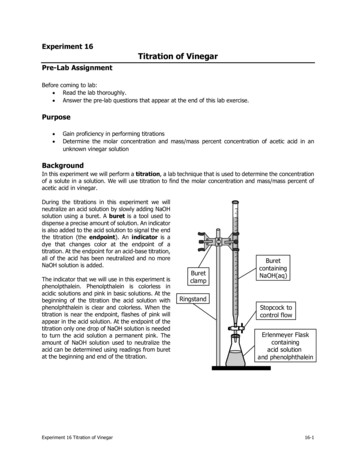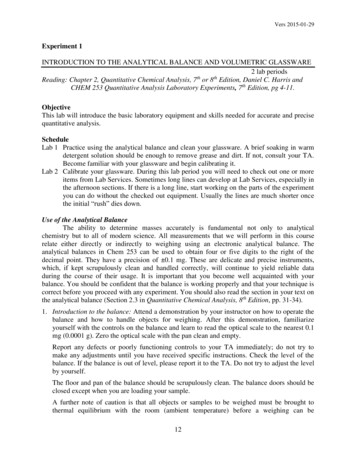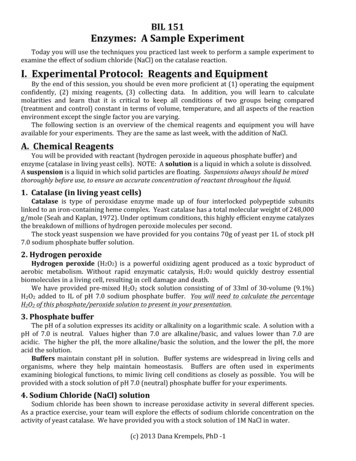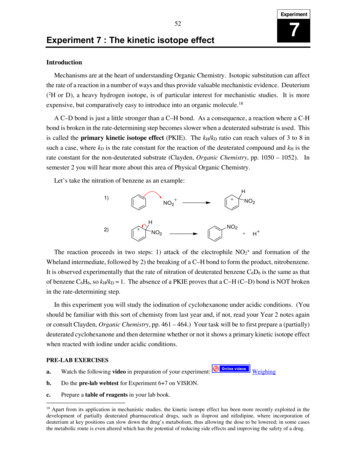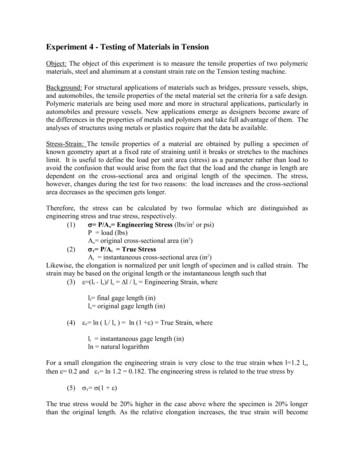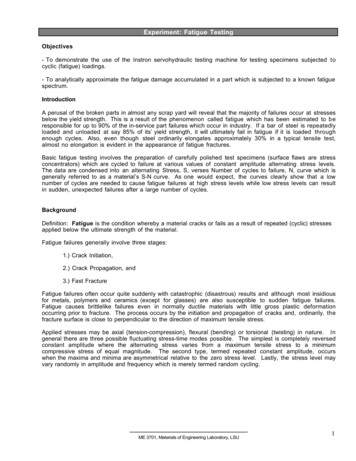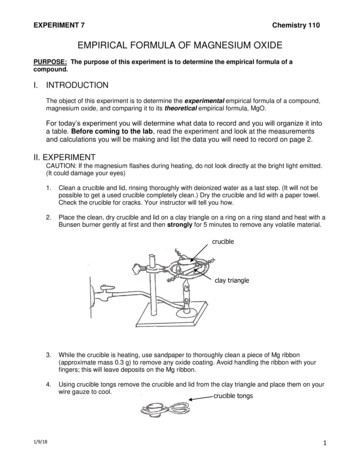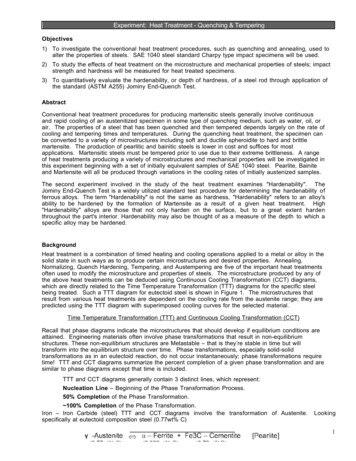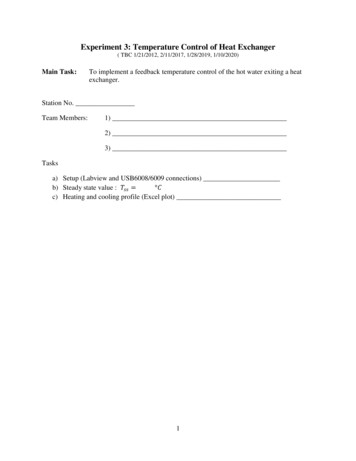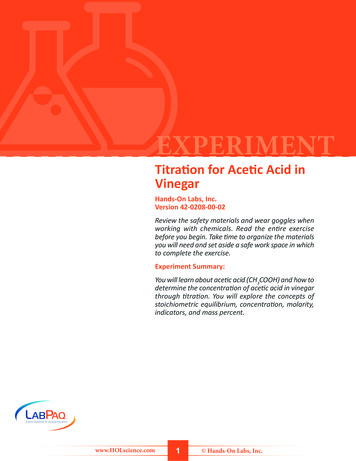
Transcription
EXPERIMENTTitration for Acetic Acid inVinegarHands-On Labs, Inc.Version 42-0208-00-02Review the safety materials and wear goggles whenworking with chemicals. Read the entire exercisebefore you begin. Take time to organize the materialsyou will need and set aside a safe work space in whichto complete the exercise.Experiment Summary:You will learn about acetic acid (CH3COOH) and how todetermine the concentration of acetic acid in vinegarthrough titration. You will explore the concepts ofstoichiometric equilibrium, concentration, molarity,indicators, and mass percent.www.HOLscience.com1 Hands-On Labs, Inc.
ExperimentTitration for Acetic Acid in VinegarLearning ObjectivesUpon completion of this laboratory, you will be able to: Define titration, titrant, analyte, and equivalence (or stoichiometric) point. Discuss why phenolphthalein is an effective pH indictor, and how it works. Describe the process and purpose of titration. Write a balanced chemical equation representing the stoichiometric equivalence point of areaction. Describe how strong and weak acids differ. Apply titration techniques to investigate acetic acid in commercial vinegar. Determine the molar concentration of acetic acid in commercial vinegar. Calculate the average concentration and the percent (%) concentration of acetic acid in vinegar.Time Allocation: 2.5 hourswww.HOLscience.com2 Hands-On Labs, Inc.
ExperimentTitration for Acetic Acid in VinegarMaterialsStudent Supplied MaterialsQuantity1111112-6Item DescriptionBottle of distilled waterDish soapPair of scissorsRoll of paper towelsSheet of white paperSource of tap waterTextbooksHOL Supplied MaterialsQuantity111111111Item DescriptionGlass beaker, 100 mLGraduated cylinder, 25 mLPair of safety gogglesPair of glovesStopcockSyringe, 10 mLTest tube clampTest tube cleaning brushExperiment Bag: Titration for Acetic Acid in Vinegar1- Phenolphthalein solution, 1%, 0.5 mL1- Vinegar, 20 mL in dropper bottle1- Pipet, short stem1- Sodium hydroxide, 0.5 M, 30 mLNote: To fully and accurately complete all lab exercises, you will need access to:1. A computer to upload digital camera images.2. Basic photo editing software such as Microsoft Word or PowerPoint , to add labels, leaderlines, or text to digital photos.3. Subject-specific textbook or appropriate reference resources from lecture content or othersuggested resources.Note: The packaging and/or materials in this LabPaq kit may differ slightly from that which is listedabove. For an exact listing of materials, refer to the Contents List included in your LabPaq kit.www.HOLscience.com3 Hands-On Labs, Inc.
ExperimentTitration for Acetic Acid in VinegarBackgroundAcetic AcidHave you ever opened a bottle of vinegar and noticed the intense scent? Now think about thesour taste you get while nibbling on a bag of salt and vinegar potato chips. You might be surprisedto learn that both the intense scent of vinegar and sour taste of salt and vinegar chips are theresult of acetic acid, the chemical component of vinegar. Acids are molecular substances thationize in water to release H ions. Acetic acid (CH3COOH) is a weak acid, which means that onlya small percentage of acetic acid molecules ionize when dissolved in water (only the hydrogenatom bonded to the oxygen ionizes). In contrast, the acidic hydrogen atoms in a strong acid arecompletely ionized in water. All acids, weak or strong, form a conjugate base and some numberof protons when dissolved in water. See Figure 1.Figure 1. Strong and weak acids. A. The weak acid, acetic acid (CH3COOH), only partially ionizesin water. Notice that of the four total hydrogen molecules in acetic acid, only one H ion isproduced in solution. B. The strong acid, nitric acid (HNO3), completely ionizes in water.The amount of acetic acid in common table vinegars, apple cider vinegar, balsamic vinegar, whitevinegar, and sherry vinegar, varies from approximately 4-6%. However, some varieties of vinegar,such as pickling vinegar or distilled vinegar, contain approximately 5-8% acetic acid.TitrationThe exact concentration of acetic acid in a bottle of vinegar can be determined through titrationwith a strong base. Titration is a quantitative, volumetric technique where a solution of a knownconcentration (titrant) is added to a solution of an unknown concentration (analyte) until theequivalence point is reached. See Figure 2. The equivalence point of a titration, also known as astoichiometric point or end point, is the moment in a titration where exactly enough titrant hasbeen added to completely react with the analyte. In an acid-base titration, the equivalence pointcan be identified through the use of a pH indicator.www.HOLscience.com4 Hands-On Labs, Inc.
ExperimentTitration for Acetic Acid in VinegarFigure 2. Laboratory titration apparatus. Alexander RathsA pH indicator is a substance that changes color when the pH of a solution changes, allowingscientists to qualitatively measure the moment when the analyte has completely reactedwith the titrant. A common indicator for a titration between a weak acid and a strong base isphenolphthalein. See Figure 3. Phenolphthalein is a pH indicator, which turns bright-pink at a basicpH of 8.2 and higher, allowing for equivalence points in titrations to be marked by the analytechanging in color from colorless to bright pink.Figure 3. Phenolphthalein added to solution. KesuWhen designing a titration between an acid and a base, it is important to know the reactionbetween titrant and analyte (chemical equation), the exact stoichiometric equivalence point(balanced chemical equation), and the concentration of the titrant. To determine the exactconcentration of acetic acid in vinegar, a titration between acetic acid (CH3COOH) and sodiumhydroxide (NaOH) will be performed, using phenolphthalein as the indicator. The balanced chemicalequation for the reaction between CH3COOH and NaOH is shown below:www.HOLscience.com5 Hands-On Labs, Inc.
ExperimentTitration for Acetic Acid in VinegarFrom the balanced equation, we know that the reaction between acetic acid and sodium hydroxideis 1:1, thus the number of moles of NaOH required to cause a change in the indicator color is equalto the number of moles of CH3COOH in the vinegar. The stoichiometric equivalence point (endpoint) of the titration will be visualized when the phenolphthalein causes the solution to changefrom a colorless solution to a bright-pink colored solution.The titration will provide the number of moles of CH3COOH present in the vinegar sample. In orderto determine the %CH3COOH in the sample, the mass percent (grams of acetic acid/grams ofvinegar) will be determined using the molar mass of CH3COOH (60.05g CH3COOH/1 mol CH3COOH)and the density of vinegar (1.00 g/mL).Titration is used in manydifferent ways to measure chemicalconcentrations in solutions: Nutritional analysisoften uses titration methods to measure acidity ina food (for example, orange juice); Blood testing andpregnancy tests may use methods of titration to measurechemical levels; Aquarium water testing uses titrationmethodologies to ensure a healthy ecosystem for aquaticpets; Winemakers may use fairly simple titration kits tomeasure the acidity of wine; The development of medications(pharmacology) by pharmaceutical companies frequentlyinvolves the use of specialized titration equipment toaccurately measure chemical quantities; Acid rain evaluationemploys titration processes to quantify the degree ofcontamination in natural rain water or snow;Wastewater analysis often uses specialized titrationequipment to analyze contamination, and thusdetermine the requirements for filtering andcleaning.www.HOLscience.com6 Hands-On Labs, Inc.
ExperimentTitration for Acetic Acid in VinegarExercise 1: Determining the Concentration of AceticAcidIn this exercise, you will determine the concentration of acetic acid (CH3COOH) in the vinegarprovided in your lab kit.Note: Please read all steps and safety information before starting the procedure.Procedure1. Gather the test tube holder, small stopcock, 10-mL syringe (titrator), and either 2 thick textbooksand the lab kit box or 5-6 thick textbooks. See Figure 4.Figure 4. Titrator and small stopcock.2. Remove the plunger from the titrator and place it back in your lab kit box.3. Attach the stopcock to the tip of the titrator by placing the larger, clear, plastic end of thestopcock into the tip of the titrator and then twist the stopcock into place. The stopcock shouldfit tightly into the titrator so that the liquid will not leak. See Figure 5.Figure 5. Fitting the stopcock into the titrator.www.HOLscience.com7 Hands-On Labs, Inc.
ExperimentTitration for Acetic Acid in Vinegar4. Stack the 5 textbooks or stack 2 textbooks on top of the lab kit box.5. Clamp the test tube holder around the middle of the titrator and slide the long end under thetop 2 books in the stack. Place a sheet of white paper next to the bottom of the stack and setthe 100 mL beaker on the sheet of white paper. The end of the stopcock should be locatednear the top of the beaker, approximately 1 cm above to 1 cm below the top of the beaker.See Figure 6.Figure 6. Titration setup.Note: It is important that the placement of the titrator allows for the white knob to be easily adjusted.If this is not the case, then either adjust the location of the books in the stack or slightly adjust wherein the test tube clamp the titrator is located.6. Use the pipet to fill the titrator with 7 - 9 mL of distilled water.Note: It is important that you use distilled water for this step and not tap water.7. Using both hands, one hand on the titrator and your other hand on the stopcock, practicereleasing water from the titrator into the beaker. The goal is to be comfortable releasing only1 drop at a time from the titrator. See Figure 7.www.HOLscience.com8 Hands-On Labs, Inc.
ExperimentTitration for Acetic Acid in VinegarFigure 7. Proper hand positioning for titration. When the open circle is facing you, the titrator isclosed, when the open circle is directly under the titrator spout, the titrator is open and liquidwill flow.8. When you are comfortable using the titrator, pour the water in the beaker down the drain,remove the titrator from the test tube clamp, and remove the stopcock from the titrator.Thoroughly dry each of these 3 items with paper towels.9. When all items are completely dry, reassemble the titration setup, as shown in Figure 6.10. Put on your safety gloves and goggles.11. With the stopcock in the closed position, fill the titrator with 9 - 10 mL of the 0.5M NaOH.12. Move the beaker away from the titrator and place a crumpled paper towel directly below thetitrator.13. Using the stopcock, allow a few drops of the NaOH to flow through the titrator into the papertowel. This will fill the tip of the titrator with NaOH solution and remove any air bubbles fromthe titrator.14. Place the paper towel with the NaOH drops into the trash and reposition the clean, dry 100mL beaker back in the titration setup, under the titrator.15. Use the graduated cylinder to measure exactly 5 mL of vinegar.16. Pour the 5 mL of vinegar into the completely dry 100 mL beaker.17. Cut off the tip of the pipet with scissors and add 2 drops of phenolphthalein to the 5 mL ofvinegar in the beaker.www.HOLscience.com9 Hands-On Labs, Inc.
ExperimentTitration for Acetic Acid in Vinegar18. Carefully swirl the mixture in the beaker to ensure that the indicator is incorporated into thevinegar; the solution will be colorless and clear.19. Read the volume of NaOH in the titrator and record in Data Table 1 of your Lab Report Assistantunder “Initial NaOH Volume (mL),” next to “Trial 1”.20. Open the stopcock and add 1 drop of NaOH to the colorless and clear vinegar sample in thebeaker. After the drop is added, gently swirl the beaker and observe the color for 5 seconds.Note: It is important to add the NaOH 1 drop at a time to avoid overshooting the titration.21. Continue adding NaOH to the beaker, 1 drop at a time, swirling and observing after each dropuntil the color changes to a bright-pink color for at least 5 seconds. See Figure 8.Figure 8. Endpoint of titration. The titration is complete when the color changes to a bright pinkfor at least 5 seconds.22. Read the volume of the NaOH solution remaining in the titrator and record this volume in DataTable 1 under “Final NaOH Volume (mL)”, next to “Trial 1”.23. Determine the total volume of NaOH used by subtracting the final NaOH volume from theinitial NaOH volume and record the total volume in Data Table 1.24. Leave the titrator assembly intact. You will need it for future titrations in this experiment.25. Pour the contents of the beaker down the drain and flush the drain with water. Thoroughlywash the beaker with soap and water to remove all of the vinegar/NaOH/indicator solutionfrom the beaker. When the beaker is clean, rinse the beaker with distilled water and thenthoroughly dry.26. Place the clean and thoroughly dry beaker back in the titration setup, under the titrator.www.HOLscience.com10 Hands-On Labs, Inc.
ExperimentTitration for Acetic Acid in Vinegar27. If necessary, add more NaOH to the titrator.Note: It is only necessary to add more NaOH to the titrator if there is less than 1 mL more than thetotal volume of NaOH used in the previous trial. For example, if the total volume of NaOH used inTrial 1 was 2.1 mL, then there needs to be at least 3.1 mL of NaOH in the titrator.28. Repeat Steps 15 through 27 two additional times (Trial 2 and Trial 3), using the vinegar providedin the lab kit.29. Average the results from the three trials and record in Data Table 1 and Data Table 2 of yourLab Report Assistant.30. Using the following equation, determine the average concentration (moles per liter) of aceticacid (CH3COOH) present in your vinegar. Record the concentration in Data Table 2.31. Using the following equation, determine % concentration (mass percent) of acetic aci
Titration for Acetic Acid in Vinegar Hands-On Labs, Inc. Version 42-0208-00-02 Review the safety materials and wear goggles when working with chemicals. Read the entire exercise before you begin. Take time to organize the materials you will need and set aside a safe work space in which to complete the exercise. Experiment Summary: You will learn about acetic acid (CH 3 COOH) and how to .

